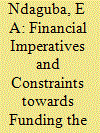| Srl | Item |
| 1 |
ID:
187587


|
|
|
|
|
| Summary/Abstract |
Electric roadways (ERs) represent a new paradigm for electrified transportation that is enabled by the emerging technology of dynamic (in-motion) wireless power transfer to electric vehicles (EVs). This kind of ubiquitous charging capability alleviates range anxiety, and can thus stimulate the adoption of EVs. However, large-scale deployment of ERs is challenging due to its high capital cost and resource-intensive nature. This paper presents a detailed analytical framework for the techno-economic assessment of planned ER projects. The methodology is illustrated using an early adoption case study on Interstate 65 in Indiana, USA. Multiple financial feasibility and risk analyses of various ER designs and implementation scenarios are conducted. The overall financial viability of the ER project is evaluated using the levelized cost of the electric roadway and its net present value. The results indicate that the EV penetration level, and especially that of heavier-duty long-haul EVs, has the greatest impact on financial viability, which suggests the critical role of sustained policies that would help accelerate adoption of this technology. The results are also supportive of developing “green” ERs, wherever synergies between renewable energy sources and traffic corridors can be exploited to co-develop solar and wind power plants with ERs.
|
|
|
|
|
|
|
|
|
|
|
|
|
|
|
|
| 2 |
ID:
160016


|
|
|
|
|
| Summary/Abstract |
Achievable and viable peace and security efforts in Southern Africa Development Community (SADC) have been limited by an over dependence on foreign and international peacekeeping. The aim of this article is to unpack financial imperatives and constraints towards funding the SADC standby force (SADCSF). Through this the article hopes to provide lessons towards a suitable and sustainable funding mechanism aimed at addressing the financial challenges confronting African standby forces in peace operations. In particular, this article focuses on the SADCSF since its establishment in 2007. This article uses information from existing statistical and research data to first, identify existing funding models in international (regional and continental) peace operation and stand-by forces across the globe. Second, using four critical analytical frames (financial viability, the nature of regionalism, fiscal sustainability and economic landscape), the article highlights various implications of a lack of funding mechanism for regional peace and security in Africa. Third, the article shows that the following are critical to find a sustainable funding mechanism for the SADCSF: the financially demanding variable geometric nature of regional integration in Africa; the proliferation of security agencies; the complex nature of terrorism and interventions; the cost of skill acquisition and training of the multidisciplinary personnel; payment of wounded soldiers and contingents and member state tight budget. Based on international experiences and local realities expounded, this article suggests lessons towards building a suitable and sustainable funding mechanism for African peace and security in general, and regional standby forces in particular.
|
|
|
|
|
|
|
|
|
|
|
|
|
|
|
|